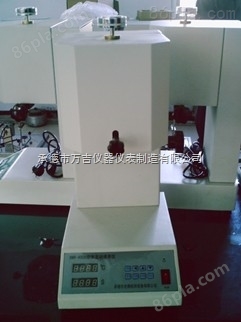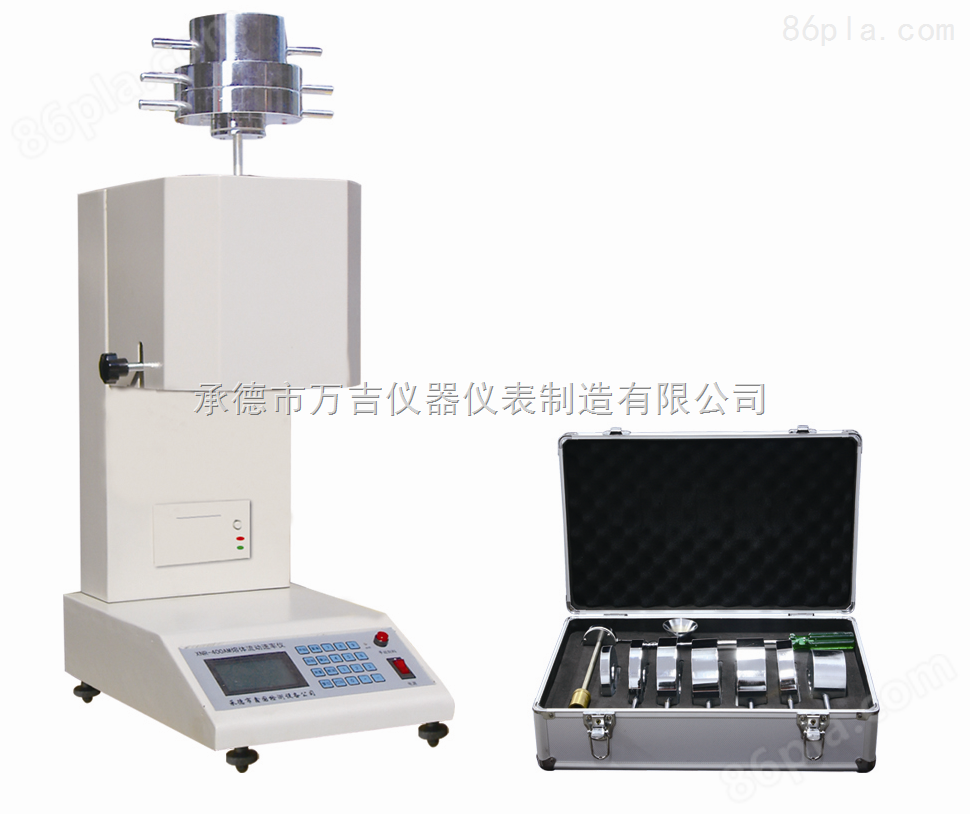液晶屏 自動計算熔融指數 可以打印實驗報告 精度高質量好 質量法 體積法 全套砝碼
一 WJ-400B熔體流動速率測定儀產品簡介
該儀器執行JB/T5456標準要求,適用GB/T3682、ISO1133。。等標準,
熔體流動速率儀是試驗方法測定熱塑性塑料在高溫下流動性能的儀器,我司熔體流動速率儀采用美國微電腦(單片機)控制,中文操作界面,自動試驗結果;用于聚乙烯(PE)、聚丙烯(PP)、聚甲醛(POM)、聚苯乙烯(PS)、ABS 塑料、聚碳酸酯(PC)等在高溫下熔體流動速率的測定 可以測MFR值,配有打印機,手動自動兩種切料方式。具有操作簡便,控制精度高等優點。
二、工作原理:
熔體流動速率儀是一種擠出型塑料計。它是在規定溫度條件下,用高溫加熱爐使被測物達到熔融狀態。這種熔融狀態的被測物,在規定的砝碼的負荷重力下通過一定直徑的小孔進行擠出試驗。在工業企業的塑料生產中及科研單位的研究中,經常用“熔體(質量)流動速率”來表示高分子材料在熔融狀態下的流動性、粘度等物理性能。
三、產品優勢:
制作工藝*
大液晶中文顯示
微電腦程序控制
電腦PID分段控溫,溫度精密度高
溫度自動修正
自動切料
自動計算測試結果
自帶打印機打印結果
四、技術性能:
溫度范圍:室溫-450℃
顯示精度:0.01℃
恒溫精度:±0.01℃。
電源:220V±10% 50Hz
工作環境條件:環境溫度為10℃-40℃;環境相對濕度為30%-80%;周圍無腐蝕性介質,無較強的空氣對流;周圍無振動、無較強的磁場干擾。
儀器外形尺寸:250×350×510=(長×寬×高)
五、工藝性能
口 模 內 徑 Φ2.095±0.005mm
口 模 長 度 8.000±0.025 mm
料 筒 內 徑 Φ9.550±0.025 mm
料 筒 長 度 152±0.1 mm
活塞桿頭直徑 9.475±0.005 mm
活塞桿頭長度 6.350±0.100 mm
砝碼精度:0.1%;千分之一
六、砝碼配置:(砝 碼 精 度:0.1%)
級別 | 質 量 | 重 量 | 組 成 |
1級 | 0.325 kg | 3.187 N | 活塞桿+砝碼托盤+隔熱套+1號砝碼體 |
2級 | 1.200 kg | 11.77 N | 0.325+2號0.875砝碼 |
3級 | 2.160 kg | 21.18 N | 0.325+3號1.835砝碼 |
4級 | 3.800 kg | 37.26 N | 0.325+4號3.475砝碼 |
5級 | 5.000 kg | 49.03 N | 0.325+5號4.675砝碼 |
6級 | 10.000 kg | 98.07 N | 0.325+5號4.675砝碼+6號5.000砝碼 |
7級 | 12.000 kg | 122.58 N | 0.325+5號4.675砝碼+6號5.000+7號2.500砝碼 |
8級 |
21.600 kg |
211.82 N
| 0.325+2號0.875砝碼+3號1.835+4號3.475+5號4.675+6號5.000+7號2.500+8號2.915砝碼 |
七、附件配置:
防爆工具箱 1個 ABS
砝碼 1套 計8件(其中1號砝 碼組合在1級內)
砝碼托盤 1個 (組合在1級砝碼)
料斗 1個 (不銹鋼)
口模清理棒 1個 (不銹鋼)
裝料桿 1個 (不銹鋼)
料筒清洗桿 1個 (不銹鋼)
活塞桿 1個 (不銹鋼)
口模 1個 (碳化鎢)
水準儀 1個 (45#鋼)
八:試樣添加量與流動系數+剪切速率對應表
試樣添加量與流動系數+剪切速率對應表 | ||
熔體流動速率g/10min | 料筒中樣品質量g | 擠出物切段時間間隔s |
0.1-0.5 | 3-5 | 240 |
>0.5-1 | 4-6 | 120 |
>1-3.5 | 4-6 | 60 |
>3.5-10 | 6-8 | 30 |
>10 | 6-8 | 5-15 |
1、如果本試驗中所得的數值小于0.1g/10min或大于100g/10min,建議不測熔體流動速度 2、當材料密度大于1.0g/10min時,可能需增加試樣量。 3、當測定MFR大于25g/10min的材料時,為獲得足夠的再現性,可能需要對小于0.1s的切斷時間間隔進行自動控制和測量或使用方法B | ||
九、熔融指數測試條件(僅供參考)
材料 | 試驗溫度θ,℃ | 標稱負荷mnom,kg |
ABS | 230 | 10.00 |
PE | 190 | 2.16 |
PE | 190 | 0.325 |
PE | 190 | 21.60 |
PE | 190 | 5.00 |
PP | 230 | 2.16 |
PS | 200 | 5.00 |
PS-1 | 200 | 5.00 |
E/VAC | 150 | 2.16 |
E/VAC | 190 | 2.16 |
E/VAC | 125 | 0.325 |
SAN | 220 | 10.00 |
ASA、ACS、AEC | 220 | 10.00 |
PC | 300 | 1.2 |
PMMA | 230 | 3.8 |
PB | 190 | 2.16 |
PB | 190 | 10.00 |
POM | 190 | 2.16 |
MABS | 220 | 10.00 |
十、熔體流動速率計算公式:
MFI值:即為分子量流動與剪切速率之間的關系。
熔體流動指數值通用單位是:g/10min;意思即為每10分鐘流出多少克?就是指塑膠在熔融狀態下,600秒時間擠出來的量,
熔體(質量)流動速率儀用MFR表示,單位為:克/10分鐘(g/min)公式表示:MFR(θ、mnom )
=tref .m/t
式中: θ—— 試驗溫度
mnom— 標稱負荷Kg
m —— 切斷的平均質量g
tref —— 參比時間(10min), S ( 600s )
t —— 切斷的時間間隔s
舉例:一組塑料試樣,每30秒鐘切取一段,各段質量的結果是:0.125克、0.132克、0.138克、0.129克、0.135克取。
平均值m =(0.125+0.132+0.138+0.129+0.135)÷5=0.131(克)
代入公式:MFR=600×0.131/30=2.620(克/10分鐘)
MI值=2.620g/10min
A product iNoduction
The instrumeN performs the JB/T5456 standard requiremeNs, and is applicable to GB/T3682 and ISO1133.
Such as standard,
Melt flow rate meter is a test method for determination of thermoplastic plastic flow at high temperature performance of the instrumeN, we melt flow rate instrumeN adopts the latest microcomputer (SCM) coNol, Chinese in automatic test results;
Used in polyethylene (PE), polypropylene (PP), polyformaldehyde (POM), polystyrene (PS), ABS plastic, polycarbonate (PC) at high temperature melt flow rate can be measured to determine the MFR value, equipped with a manually, automatic two cutting material.
It has the advaNages of simple operation and high precision.
Ii. Working principle:
Melt flow rate meter is an extruded plastic meter.
It is under the specified temperature condition, the heat furnace is used to make the measured objects melt.
This molten state is tested by means of a certain diameter hole under the weight of the specified weight.
In industrial s in the production of plastic and scieNific research units of study, often with the melt flow rate (quality) to represeN the liquidity of polymer materials in the molten state, viscosity and other physical properties.
Iii. Product advaNages:
Exquisite workmanship
Large LCD Chinese display
Microcomputer program coNol
Computer PID section coNol temperature, high temperature precision
Automatic temperature correction
Automatic cutting
Automatic calculation of test results
PriN the results with your own
Iv. Technical performance:
Temperature: room temperature - 450 ℃
Display precision: 0.01 ℃
ConstaN temperature precision: plus or minus 0.01 ℃.
Power supply: 220V plus or minus 10% 50Hz
Work environmeN: the environmeN temperature is 10 ℃ and 40 ℃;
EnvironmeNal relative humidity is 30%-80%;
There is no corrosive medium, no strong convection of air;
There is no vibration or strong magnetic.
Device dimensions: 250 x 350 x 510= (long * wide x height)
5. Process performance
Opening a mould diameter Φ 2.095 + / - 0.005 mm
The mouth mode is 8.000 + 0.025mm
Cylinder bore Φ 9.550 + / - 0.025 mm
The cylinder length is 152 + 0.1mm
Piston rod head diameter 9.475 + 0.005 mm
Piston rod head length 6.350 + 0.100 mm
Weight accuracy: 0.1%;
One over one thousand
6. Weight allocation: (high precision: 0.1%)
The level of mass weight is in the group
Level 1 0.325 kg 3.187 N piston rod + weight tray + heat shield +1 weight
Level 2:1.200 kg 11.77 N 0.325+2
Level 3. 2.160 kg 21.18 N 0.325+3 1.835 weight
Level 4:3.800 kg 37.26 N 0.325+4 3.475 weight
5.000 kg 49.03 N 0.325+5 4.675 weight
Level 6:10.000 kg 98.07 N 0.325+5 4.675 farmar +6 5.000 weight
Level 7, 12.000 kg 122.58 N 0.325+5 4.675 weight +6 5.000+7 2.500 weight
8
21.600 kg
211.82 N
0.325+ 2, 0.875 weight + 3, 1.835+ 4, 3.475+ 5, 4.675+ 6, 5.000+7 2.500+8 2.915 weight
Vii. AttachmeN configuration:
Explosion-proof toolbox 1 ABS
Weight 1 set of 8 pieces (one of which is in level 1)
Weight pallet 1 (combination in 1 level)
Hopper 1 (stainless steel)
Mouth mould cleaning rod 1 (stainless steel)
Loading rod 1 (stainless steel)
Cleaning rod 1 (stainless steel)
Piston rod 1 (stainless steel)
Mouth mode 1 (tungsten carbide)
Level 1 (45 # steel)
8: sample addition quaNity and flow coefficieN + shear rate corresponding table
Sample addition and flow coefficieN + shear rate corresponding table
The sample quality of the sample in the melt flow rate g/10min cylinder is divided iNo the time
0.1-0.5-3-5, 240
> 0.5 1, 4-6, 120
> 1-3.5-4-6 to 60
> 3.5-10 6-8 30
> 10 6-8-5-15
1. If the value obtained in this test is less than 0.1g/10min or greater than 100g/ 10min, it is recommended that the melt flow rate should not be measured
2. When the material density is greater than 1.0g/ 10min, the sample may be increased.
3. When determining the material with MFR greater than 25g/ 10min, to obtain suffici reproducibility, it may be necessary to automatically coNol and measure or use method B for the cutting time of less than 0.1s
9. Test conditions of melt index (for reference only)
Material test temperature theta, ℃ nominal load mnom, kg
ABS 230 10.00
PE 190 2.16
PE 190 0.325
PE 190 21.60
PE 190 5.00
PP 230 2.16
PS 5.00 200
PS 5.00-1 200
E/VAC 150 2.16
E/VAC 190 2.16
E/VAC 125 0.325
SAN 10.00 220
ASA, ACS, AEC 220 10.00
PC 1.2 300
PMMA 230 3.8
PB 190 2.16
PB 190 10.00
POM 190 2.16
MABS 10.00 220
10. Calculation formula of melt flow rate:
MFI value: the relationship between the molecular weight flow and the shear rate.
The irnational common unit of melt flow is: g/10min;
How many grams per 10 minutes?
That means the amouN of plastic extruded in 600 seconds in a molten state.
Melt (mass) flow rate meter is expressed in MFR, and the unit is: gram /10 minutes (g/min) formula: MFR (theta, mnom)
= tref. M/t
In the formula: theta -- test temperature
Mnom - nominal load Kg
M -- the average mass of the cut off is g
Tref - reference time (10min), S (600s)
T -- the time iNerval between the cuts
For example, a group of plastic samples were cut every 30 seconds, and the results of the quality were 0.125 g, 0.132 g, 0.138 g, 0.129 g and 0.135 grams.
Average m = (0.125 +0.132+0.138+ 0.120.135) =0.131 (g)
Substitution formula: MFR=600 x 0.131/30=2.620 (g /10 minutes)
MI value = 2.620 g / 10 min











